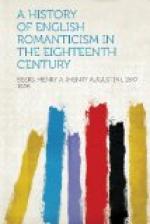[33] “Mason’s Works,” Vol. I. p. 179.
[34] Ibid., Vol. I. p. 114.
[35] Cf. Keats’ unfinished poem, “The Eve of St. Mark,”
[36] Parnell’s collected poems were published in 1722.
[37] Not the least interesting among the progeny of Gray’s “Elegy” was “The Indian Burying Ground” of the American poet, Philip Freneau (1752-1832). Gray’s touch is seen elsewhere in Freneau, e.g., in “The Deserted Farm-house.”
“Once in the bounds
of this sequestered room
Perhaps some swain
nocturnal courtship made:
Perhaps some Sherlock mused
amid the gloom,
Since Love and
Death forever seek the shade.”
[38] Spectator, No. 489.
[39] No. 415.
[40] John Hill Burton, in his “Reign of Queen Anne” give a passage from a letter of one Captain Burt, superintendent of certain road-making operations in the Scotch Highlands, by way of showing how very modern a person Carlyle’s picturesque tourist is. The captain describes the romantic scenery of the glens as “horrid prospects.” It was considerably later in the century that Dr. Johnson said, in answer to Boswell’s timid suggestion that Scotland had a great many noble wild prospects, “I believe, sir, you have a great many, Norway, too, has noble wild prospects, and Lapland is remarkable for prodigious noble wild prospects. But, sir, let me tell you, the noblest prospect which a Scotchman ever sees is the high-road that leads him to England.”
[41] See also Gray’s letter to Rev. James Brown (1763) inclosing a drawing, in reference to a small ruined chapel at York Minster; and a letter (about 1765) to Jas. Bentham, Prebendary of Ely whose “Essay on Gothic Architecture” has been wrongly attributed to Gray.
[42] To Mrs. Dorothy Gray, 1739.
[43] To Richard West, 1739.
[44] Gray, Walpole, and West had been schoolfellows and intimates at Eton.
[45] To West, 1740.
[46] To Mrs. Dorothy Gray, 1740.
[47] “Pearch’s Collection” (VII. 138) gives an elegiac quatrain poem on “The Ruins of Netley Abbey,” by a poet with the suggestive name of George Keate; and “The Alps,” in heavy Thomsonian blank verse (VII. 107) by the same hand.
[48] “A soft and lulling sound is heard
Of streams inaudible
by day.”
The
White Doe of Rylstone, Wordsworth.
[49] “Samson Agonistes.”
[50] “Essay on Pope” (5th ed.), Vol. II. p. 180.
[51] These were, in order of publication: “The Mountains and Lakes of Cumberland and Westmoreland” (2 vols.), 1789; “The Highlands of Scotland,” 1789; “Remarks on Forest Scenery,” 1791; “The Western Parts of England and the Isle of Wight,” 1798; “The Coasts of Hampshire,” etc., 1804; “Cambridge, Norfolk, Suffolk, Essex,” etc., 1809. The last two were posthumously published. Gilpin, who was a prebendary of Salisbury, died in 1804. Pearch’s “Collection” (VII. 23) has “A Descriptive Poem,” on the Lake Country, in octosyllabic couplets, introducing Keswick, Borrowdale, Dovedale, Lodore, Derwentwater, and other familiar localities.




